![]()
![]()
![]()
Use LEFT and RIGHT arrow keys to navigate between flashcards;
Use UP and DOWN arrow keys to flip the card;
H to show hint;
A reads text to speech;
35 Cards in this Set
- Front
- Back
- 3rd side (hint)
|
Geometric properties |
Spatial resolution and distortion Unlike the photographic properties of ir exposure and contrast, which control the visibility of detail, the ______ control detail itself |
|
|
|
Spatial resolution (recorded detail) |
Is one of the two geometric properties of image quality.
Is the degree of geometric sharpness or accuracy of the structural lines actually recorded in the image
Is dependent on Matrix size, pixel size, and grayscale bit depth |
|
|
|
Definition, sharpness, recorded detail |
Spatial resolution is also referred to as |
|
|
|
Radiographic resolution tool |
Is composed of pairs of lines a set distance from one another The point at which the viewer can discern the closest pair of lines from each other represents the 1p / mm reading. Most humans visual limit is the range of 5 1P/mm High spatial resolution represents a high-frequency signal that is capable of Imaging smaller objects Low spatial resolution represents a lower frequency signal that can only image larger objects |
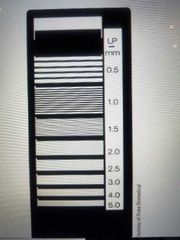
|
|
|
High frequency |
High spatial resolution is expressed as |
|
|
|
Spatial frequency |
High frequency (shorter wavelength signal) : represents pairs of lines that can be visualized very close together. AKA, high resolution Low-frequency (long-wavelength signal) : represents pairs of lines that are further apart. AKA, low resolution |
|
|
|
Unsharpness |
Lack of sharp definition of fine detail |
|
|
|
Point spread function (PSF) |
Measures penumbra and is used to quantify digital system spatial resolution |
|
|
|
Resolution test tool |
Spatial resolution is usually evaluated during quality control testing by Imaging a _____.
In a clinical situation, small structures are the easiest to examine and evaluate spatia resolution.
The trabecular pattern of bone is an excellent guide post to image resolution |
|
|
|
Spatial resolution |
Describes the ability of an Imaging system to accurately display objects in two dimensions Is higher when two objects can be demonstrated to be smaller or closer together |
|
|
|
Spatial frequency |
Determined by measuring distance between pairs of lines distinct from one another |
|
|
|
Measures of recorded detail (spatial resolution) |
Those used most often to describe and compare Imaging systems are Spatial frequency (PSF) Point spread function (LSF) Line spread function (ESF) Edge spread function
(MTF) modulation transfer function Noise |
|
|
|
Point spread function (PSF) |
Expression of the boundaries of an image. Determined by a mathematical measurement of an image produced at a single point |
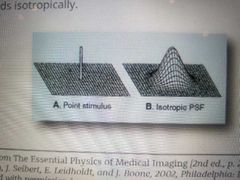
|
|
|
Edge spread function (ESF) |
Expression of the boundaries of an image |
|
|
|
(PSF) (ESF) (LSF) |
All Express the boundaries of an image In film screen radiography this aspect was called penumbra or blur |
|
|
|
Test tools |
Are simply pairs of lines that are different distances from one another. It is imaged by the system, and the viewer determines the smallest pair of lines that can be visualized. The pairs of lines are then measured as line pairs per unit of length, usually in mm or cm. |
|
|
|
(MTF) Modulation transfer function |
Measures the accuracy of an image compared to the original object on a scale of 0 - 1.
Measurement of 1 represents perfect reproduction of original object (impossible with current tech)
Is comprised of spatial frequency components
PSF, LSF, ESF
As the spatial frequency of objects Rises, the ____ decreases |
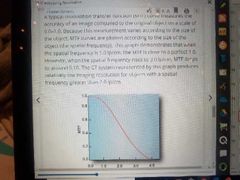
|
|
|
Rises |
As the spatial frequency of objects Rises, the MTF.. |
|
|
|
1 |
In medical imaging, the goal is to produce an image with an MTF value as close as possible to ___, at high spatial resolution |
|
|
|
Imaging noise |
Background information that the image receptor receives Is the total noise that the IR receives. It includes System noise, Ambient noise, and Quantum noise |
|
|
|
(SNR) signal-to-noise ratio |
Is a measure of signal strength relative to total noise.
Depends on the amount of radiation exposure to the detector and the detectors detective Quantum efficiency Higher ___ is very desirable for optimum image quality |
|
|
|
(CNR) Contrast to noise ratio |
Is defined as the ratio of the difference of signal intensities of two regions of interest to the Imaging noise Ratio of ROI signal differences to noiseCNR values are not possible without high SNR values, therefore these two metrics can be used to validate one another CNR values are not possible without high SNR values, therefore these two metrics can be used to validate one another CNR values are not possible without high SNR values, therefore these two metrics can be used to validate one another |
|
|
|
Noise |
Expressed as signal-to-noise ratio (SNR) Quantified as a numerical value Higher SNR is very desirable for optimal image quality. Contrast to noise ratio CNR |
|
|
|
Noise level rises |
When this happens, more complex computer processing algorithms may be necessary. When their limits are reached, degradation of the image occur |
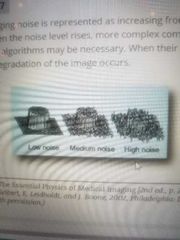
|
|
|
How to improve Recorded detail (spatial resolution) |
Eliminate motion, with shorter exposure time. Or synchronize exposure with motion
Reduce OID
Reduce focal spot size
Use detector with smallest detector element (DEL)
Reduce intensifying screen phosphor size and concentration film system.
Increase SID |
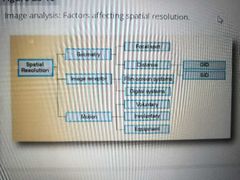
|
|
|
Voluntary motion |
Is best reduced through effective communication. Technologist must establish atmosphere by being professional and competent |
|
|
|
involuntary motion |
Best reduced through short exposure time Or immobilization |
|
|
|
Motion |
Voluntary Involuntary Equipment |
|
|
|
Digital systems affecting recorded detail |
CR Imaging plates -Limitations similar to intensifying screens. -Size of PSP Crystal. -Also affected by image reader device (IRD)
DR
- primary limitation is size of detector element (DEL) 200 microns, 140 microns, 125 microns, Etc Image processing system limits recorded detail depending on - accusation and display matrix - pixel size - grayscale bit depth |
|
|
|
Focal spot size affecting recorded I detail (spatial resolution) |
Line Focus principle. Creates a penumbra (P) and inherent loss of sharpness due to focal spot geometry and distances. Focal spot size is a major factor in spatial resolution. Smaller focal spot yield increased resolution |
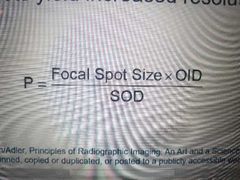
|
|
|
Attenuation / absorption unsharpness |
Some degree of image unsharpness occurs due to shape and size of patient Anatomy. Related to beam Divergence and incongruence with anatomical structures |
|
|
|
Assessing recorded detail (spatial resolution) |
Clinical evaluation - Trabecular pattern of bone. - Cortex of bone. - Bronchopulmonary markings of lungs |
|
|
|
Focal spot size |
Is controlled by the line Focus principle. Is a major controller of spatial resolution because it controls penumbra As it decreases in size, penumbra also decreases, thus increasing resolution |
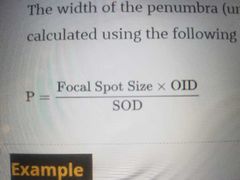
|
|
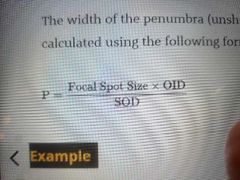
|
The width of the penumbra can be mathematically calculated using the following formula |
|
|
|
Umbra Vs. Punumbra |
Is the distinctly sharp area of Shadow or the region of complete shadow. Versus. Is the imperfect, unsharp Shadow surrounding the Umbra. |
|

